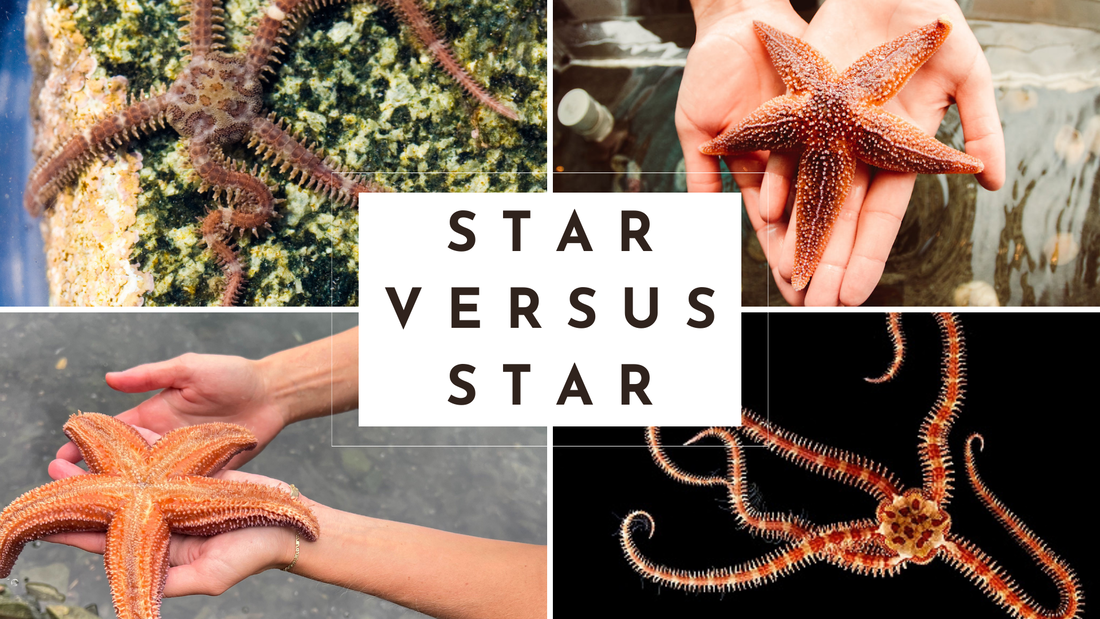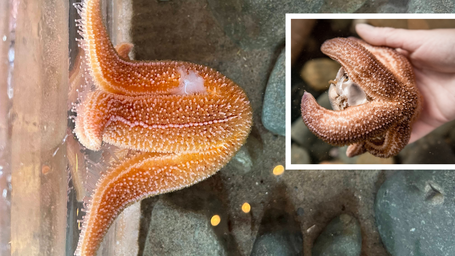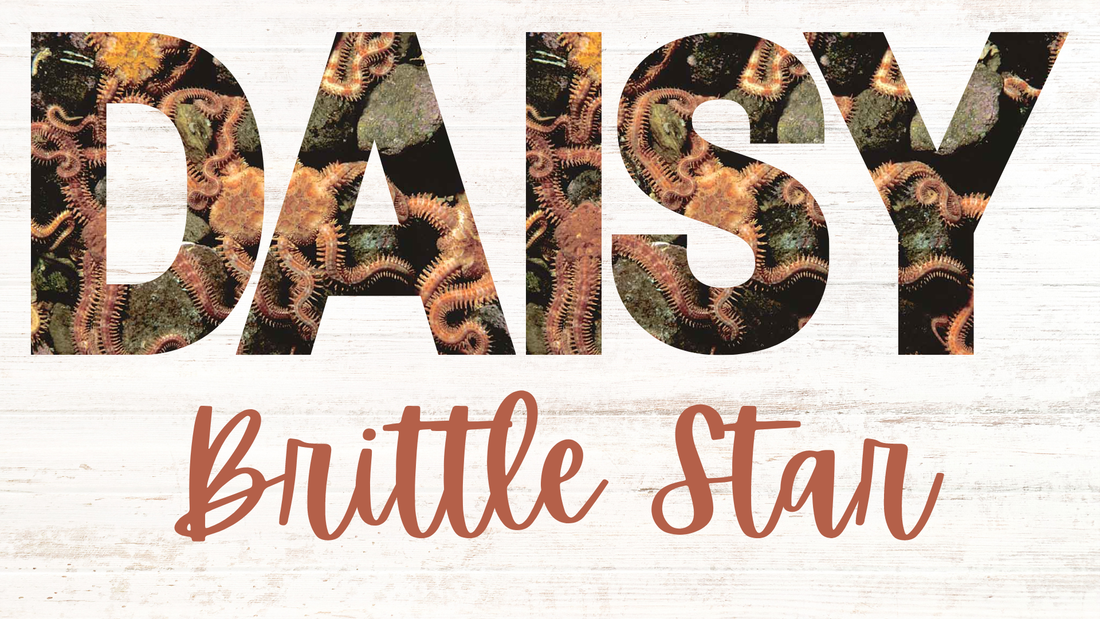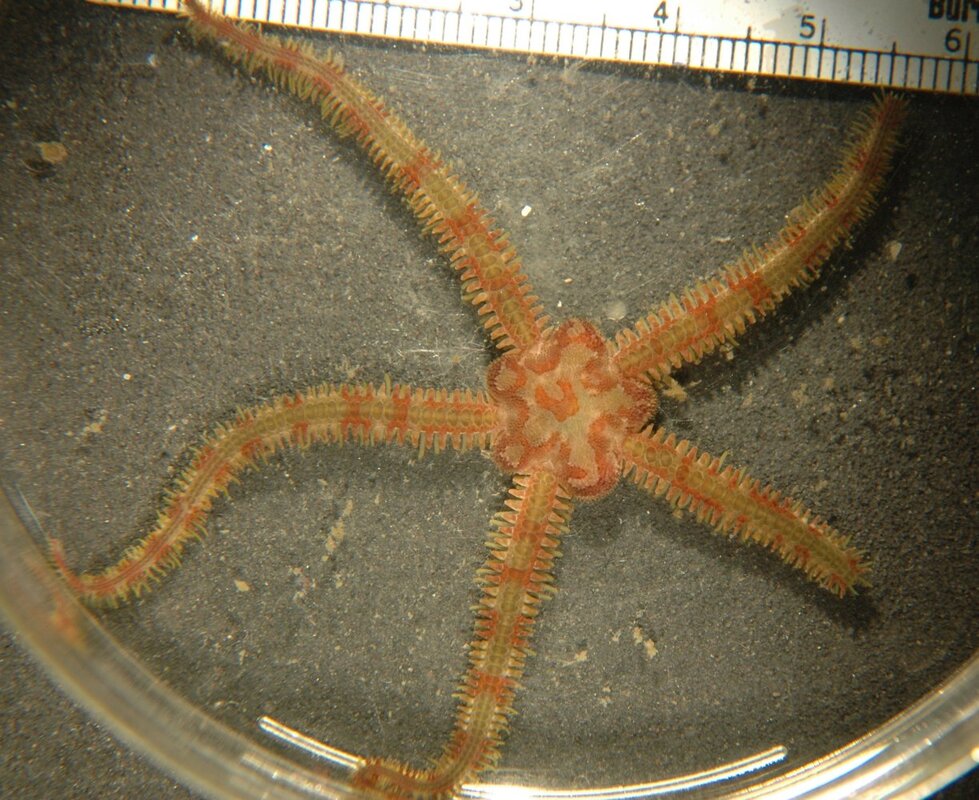|
Written by Laura Eamon If you’ve ever visited the Touch Tank Hut or been on one of our Tidal Trekker excursions, you would be familiar with the well known common sea star (Asterias rubens)! But did you know we have another star-shaped marine critter living in our ocean? The daisy brittle star (Ophiopholis aculeata) is closely related to the sea star, but they have some peculiar differences in their appearance and the way they live in their marine habitat. Let’s "star"t where these two species are similar: they’re both echinoderms (from the Greek echin, meaning spiny, and derma, meaning skin). This means they have a hard, spiny covering or skin. It also means their body parts are arranged around a central point like a wheel or a star! When overturned, echinoderms can right themselves back up. They have a unique vascular system that branches into their tube feet! Now let’s dive into some of the specifics.  THE COMMON SEA STAR (Asterias rubens) The common sea star, so sweet and unassuming to the eye, is actually a major predator in rocky subtidal ecosystems, like the ones found along the Atlantic coasts of Nova Scotia and Newfoundland. MOVEMENT The sea star can rest stationary on rocks or creep along slowly as its tube feet extend, grip, release, extend, and grip again. Even though the bottoms of those little tube feet resemble a suction cup, the gripping is actually the result of adhesive chemicals. Impressively, sea stars can move forward no matter what part of their star shaped body is pointed that way! Sea stars show the strongest response in righting themselves after being shifted upside down. Like little gymnasts, they use their tube feet and arms to perform a slow, graceful somersault to restore their normal position. FEEDING The tube feet along the sea star’s five arms are used for so much! They help move around, but they are also important for feeding. Sea stars use their tube feet to tightly grasp their prey, which is usually molluscs like mussels or clams. Get ready for the gross part! The sea star then turns part of its stomach inside out through its mouth and into the narrow opening between the halves of its prey’s shell. The digestive system of the sea star releases juices that begin digesting the mollusc inside its shell. The stomach is then brought back inside the sea star’s body where digestion of the mollusc's now liquefied body is completed. Because of this intricate feeding process, sea stars can consume prey much larger than its little mouth! Get this: sea stars actually eat ophiuroids like the daisy brittle star. THE DAISY BRITTLE STAR (Ophiopholis aculeata) Brittle star species are found at all depths worldwide. Ophiopholis aculeata is found mainly in subtidal areas down to ~300m depth but has been reported down to 2250m! They may dwell on rock, sand, mud, live in burrows, or be anchored to other organisms such as sponges and corals. MOVEMENT Brittle stars may still be shaped like a star with five arms, but their bodies are much different than common sea stars. Where a common sea star might resemble a drawing of a Christmas tree star topper or the bright yellow star emoji, a daisy brittle star has a thick central disc and five long, flexible (read: squiggly) arms. Because of this, they are the most agile of echinoderms, taking long strides by lashing their arms like little snakes instead of inching along. The tube feet of a brittle star don’t match the tube feet of a sea star: they’re missing the suction-cup-like ends. They still release adhesive chemicals though, so they can grip underwater surfaces. In shallow water, brittle stars will hide their central disc,and expose only their flowy arms outside the shelter. Their centres generally remain concealed under rocks, in crevices, or among algae unless they’re escaping predation or reproducing. Known predators include the green sea urchin (Strongylocentrotus droebachiensis) and common sea stars (Asterias rubens), both of whom are frequent Touch Tank Hut regulars! We’ve got our job cut out for us keeping everybody fed and safe at Back to the Sea. FEEDING Brittle stars show all kinds of feeding behaviour. They are suspension feeders meaning they capture and ingest particles floating around in the water. These particles include phytoplankton, zooplankton, and bacteria. They can be detritivores, which means they feast on dead organic material. They can also show predatory behaviour feeding on crustaceans, bivalves, and even eggs! No matter who your favourite is, be sure to be respectful of all sea stars and marine life if you encounter them out in the wild or here at Back to the Sea's touch tanks! Visit this summer to sea some of these stars from the ocean at eye level. Sources
0 Comments
Leave a Reply. |
Categories
All
We send blog recaps with in all our quarterly newsletters!
|




